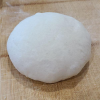wquiles
Well-Known Member
I have been baking sourdough bread at home for a couple of years, but everything was "by eye", without measuring "exactly" anything. But I was never quite satisfied with the flavor - too dull. So I found this bread-making site, created a new starter following the pineapple juice method, and this time around I bought a kitchen scale and I am trying to be more consistent. While developing the new starter, I noticed inconsistencies temperature-wise, so I decided to make my DIY proofing box as well (right now works between 76-78F).

This is my current method:
- Thu afternoon, take starter (5oz) from fridge (getting the starter ready takes about 1-2 weeks - its own separate process!)
- Mix 1oz of starter, with 2oz water and 2oz flour - put in proofing box
- Mix 2oz of starter, with 4oz water and 4oz flour (this is the levain) - put in proofing box
- Friday mid morning, put starter back in fridge (at least 12h have passed)
- Around mid-day Friday, mix 17.5oz of flour with 8.8oz of water - let sit for 30min
- Mix flour with water with levian. At this point the mix is way too messy, and too wet for me to mix, so I add about 2oz of flour to get a more manageable consistency. I add the .35oz of salt at this point.
- Fold and let rest 30min - do this 4-5 times
- let rest until early evening for bulk fermentation 4-5h (in the proofing box)
- cut in two, shape, put in banneton, covered in air-tight plastic bag and store in fridge
- Sat morning, about 9am, bring oven and dutch oven to 500F - wait 30min after oven has reached temperature
- Once ready, transfer bread into dutch oven (on wax paper), put in oven (set to 450F), bake with lid on for 20min. Note that the bottom of my dutch oven has a small amount of flour and the bread goes on top of a piece of parchment paper - this helps the bottom get cooked but not quite totally burned.
- Remove lid, bake for another 20min
- Remove bread, place on cooling pad, wait at least 90min to 2 hours before cutting/eating
For some photos, this is while the bread is doing the bulk fermentation and I am doing the folds:

This is when I cut (above) in two, to start shaping:

This is one of the two loafs shaped, and ready to go into the fridge:

Scored, and ready for the first part of the baking - with the lid on:

This is how one of the two loafs looks like after the first bake portion with the lid on:

And after baking, these are the two loafs I got yesterday (Sat):

and

After 2 hours (so it is fully cooked internally), this is how it looks like:



This is my current method:
- Thu afternoon, take starter (5oz) from fridge (getting the starter ready takes about 1-2 weeks - its own separate process!)
- Mix 1oz of starter, with 2oz water and 2oz flour - put in proofing box
- Mix 2oz of starter, with 4oz water and 4oz flour (this is the levain) - put in proofing box
- Friday mid morning, put starter back in fridge (at least 12h have passed)
- Around mid-day Friday, mix 17.5oz of flour with 8.8oz of water - let sit for 30min
- Mix flour with water with levian. At this point the mix is way too messy, and too wet for me to mix, so I add about 2oz of flour to get a more manageable consistency. I add the .35oz of salt at this point.
- Fold and let rest 30min - do this 4-5 times
- let rest until early evening for bulk fermentation 4-5h (in the proofing box)
- cut in two, shape, put in banneton, covered in air-tight plastic bag and store in fridge
- Sat morning, about 9am, bring oven and dutch oven to 500F - wait 30min after oven has reached temperature
- Once ready, transfer bread into dutch oven (on wax paper), put in oven (set to 450F), bake with lid on for 20min. Note that the bottom of my dutch oven has a small amount of flour and the bread goes on top of a piece of parchment paper - this helps the bottom get cooked but not quite totally burned.
- Remove lid, bake for another 20min
- Remove bread, place on cooling pad, wait at least 90min to 2 hours before cutting/eating
For some photos, this is while the bread is doing the bulk fermentation and I am doing the folds:

This is when I cut (above) in two, to start shaping:
This is one of the two loafs shaped, and ready to go into the fridge:

Scored, and ready for the first part of the baking - with the lid on:

This is how one of the two loafs looks like after the first bake portion with the lid on:

And after baking, these are the two loafs I got yesterday (Sat):

and

After 2 hours (so it is fully cooked internally), this is how it looks like:


Last edited:



